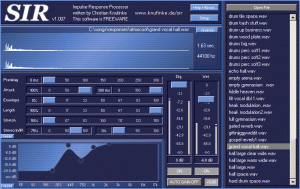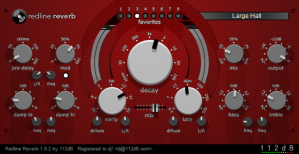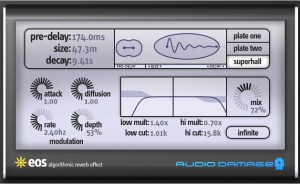Knufinke SIR1

SIR1 is a freeware convolution reverb, using impulse response (IR) files to achieve a great variety of excellent sounds.
——————————————————————————–
112dB Redline Reverb

Developed by Martijn Zwartjes, who used to work at Native Instruments, the Redline Reverb’s first incarnations were the Rev-6 and Space Master ensembles for NI’s Reaktor. Both of those are still favourites among many producers, and the Redline just builds on their sound, performance and musicality even further. A future classic.
I gather this plugin scored 10/10 in a Computer Music review recently, and also won their Best Plugin of the Year (of any type), so it’s obviously worth checking out.
Wave Arts MasterVerb 5

I couldn’t not mention MasterVerb. It sounds great, is very versatile and has a very cool and clear interface, so it’s quick and easy to tweak settings.
It would compete pretty well against most convolution reverbs, but being of the algorithmic variety MasterVerb uses about half the processing power of most convolution plugins.
——————————————————————————–
Audio Ease Altiverb 6

The established daddy of all reverb plugins, and something of an industry standard. No, it’s not cheap, yes you need a powerful computer to run it… but the sound and flexibility it affords is generally well worth it. The XL version also includes surround reverb and a TDM version for Pro Tools.
Waves IR1
As far as I know, the IR1 is also unique for it’s parametric controls, whereby you can plot your settings on the interface display in the same way as you would on a parametric EQ.
——————————————————————————–
M-Audio Wizooverb W5

Surround mixing can get very complicated very quickly, but I think this reverb handles it with ease due to its sleek and clear interface. Obviously the sound quality is top of the line as well! It features HDIR (High Definition Impulse Response), and can be run in stand-alone mode or inside your host application.
Incidentally, the W5’s slimmer stereo-version sibling Wizooverb W2 is also a strong contender for best reverb overall.
——————————————————————————–
Waves Renaissance Reverb

Some of the most useful reverbs are parts of bundles or series of plugins that work really well together. The Renaissance Reverb is my personal go-to reverb, as are many of the Waves plugins, especially the Renaissance series. A well balanced reverb in terms of overall sound and versatility, with simple but effective graphic EQs for quick shaping of the reverb return signal – great for efficiently slotting the sound into a busy mix without adding clutter or low-frequency mush.
Waves TrueVerb

Another Waves reverb plugin, but this one is more of a room emulator than a conventional reverb like the Renaissance Reverb. Together, they’re an excellent combination.
TrueVerb actually combines an Early Reflections simulator with its standard reverb algorithms, to produce very natural-sounding room sounds.
——————————————————————————–
Kjaerhus Audio Classic Reverb

The Classic Reverb from Kjaerhus Audio is probably the best basic free reverb plugin out there. Low CPU usage, but it still handles sampling rates up to 96kHz, meaning that if you’re aiming for super-smooth reverb tails on a budget, this is the way to go.
More info: The Kjaerhus Audio website is no longer in operation, but you can still download the plugin for free from the good people at KVR Audio,
Smartelectronix / Magnus Ambience

Another excellent reverb with a great reputation. Created by a guy called Magnus, apparently in his spare time between ‘studies’, the sound quality is much better than you might expect – in fact a lot of people swear by Ambience as their go-to reverb. Magnus also lets you decide how much you want to pay for the plugin, what a guy.
——————————————————————————–
Lexicon PCM Native Reverb Bundle
This reverb collection from the long-serving hardware effect/processor company really is in a league of it’s own, both in terms of price and quality. It’s the company’s first step into the purely digital plugin domain, and as they’ve set the gold standard for digital reverbs with their hardware over the last 40 years, they really had to deliver. Fortunately it seems that they did! Another nail in the coffin for cumbersome external hardware units :)
——————————————————————————–
Audio Damage Eos

I really like Audio Damage software, apart from anything else their plugin and instrument interfaces are refreshingly different and stylishly minimal. I also like their audacious and witty Avatar-referencing sales blurb, so I’m going to quote it here, hope you don’t mind:
“Where Eos really comes into its own is when you drop Superhall on your piano or synthesizer tracks. The long modulated hall sounds of Eno-style ambience are where Eos thrives, something that is made of unobtanium with convolution ‘verbs. Quite simply, an impulse response can not do what Eos does.”
Eos only has 3 algorithms, but it’s so well thought out that in my opinion they cover everything you’ll need, at least for modern/electronic styles.
PSP EasyVerb
——————————————————————————–
Space Designer Convolution Reverb.
 One great thing about all the major modern sequencers – Logic, Pro Tools, Cubase, Sonar, Digital Performer etc. – is that the average quality of the bundled plugins and instruments is actually very high these days, and certainly for the most part useable in ‘pro’ productions. Don’t let anyone tell you otherwise! Something to bear in mind through all of this is that no-one (except maybe another producer) is ever going to come and say to you, “I really liked your track, it was really amazing… it’s just a shame about the slightly brittle quality of the reverb tails…”
One great thing about all the major modern sequencers – Logic, Pro Tools, Cubase, Sonar, Digital Performer etc. – is that the average quality of the bundled plugins and instruments is actually very high these days, and certainly for the most part useable in ‘pro’ productions. Don’t let anyone tell you otherwise! Something to bear in mind through all of this is that no-one (except maybe another producer) is ever going to come and say to you, “I really liked your track, it was really amazing… it’s just a shame about the slightly brittle quality of the reverb tails…”The best things about using the reverb plugins supplied with your sequencer are that a) you don’t have to pay any more, and b) they are likely to run more efficiently within their host program than a third-party plugin. Shown here is Logic Pro 9′s Space Designer Convolution Reverb.
——————————————————————————–
Universal Audio EMT 140 Classic Plate Reverberator

Having just written the above, I’m going to switch back to gear fetish mode so I can tell you about the EMT 140 Classic Plate Reverb. It was EMT’s founder Wilhelm Franz who actually invented plate reverb in the late ’50s with the original EMT 140, so the pedigree for this plugin is pretty impressive. UA locked their ‘DSP circuit modelling experts’ in a room for four months until they came up with this emulation, so for their sakes, give it a try.
——————————————————————————–


Best reverb Plugin
ReplyDeleteHi you can check out mine and let me know thanks.
Audio Ease Altiverb 7 XL
ReplyDeleteI am very impressed with your post because this post is very beneficial for me.